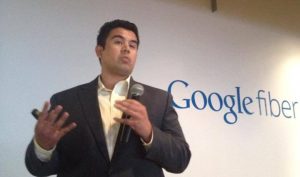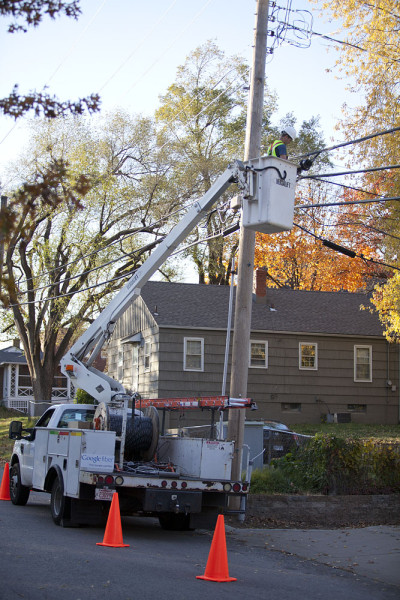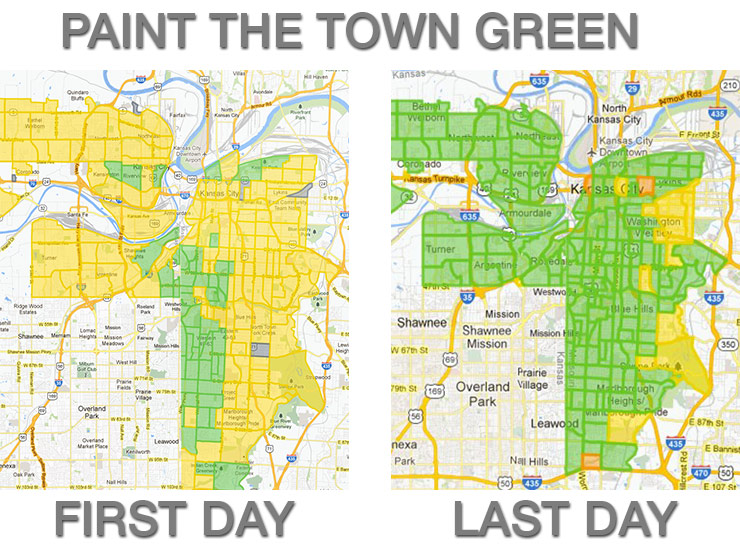A couple of weeks ago, KCTV5 reported that Google’s effort to bridge the digital divide is coming up short. It’s great to see local news covering this issue and to see broader exposure for partners like Connecting for Good, who have worked so hard to make a difference.
But the headline is misleading, and it’s not the first of its kind by a longshot. There is a clear, long line of reportage—locally and nationally—to suggest Google has been the villain in Kansas City’s digital divide story.
During the initial launch period in 2012, Wired reported “Google Fiber Splits along Kansas City’s Digital Divide.” Two years later, Newsweek asked “Is Google Making the Digital Divide Worse?” followed by the WSJ with, “Google Fiber Is Fast, but Is It Fair?” More recently, Fast Company claimed “the digital divide is as wide as ever” in KC. Those are just a few over the years.
I’m here today to tell you that the idea that Google is some kind of digital divide villain in our city is preposterous. It’s simply not true, and perpetuating it is damaging for Kansas City.
I feel that it is incumbent on us as a community to recognize this, and in this post I’ll explain why.
But first, I need to make something clear about KC Digital Drive.
It’s easy for us to be accused of shilling for Google. Because we believe in the importance of fiber-optic infrastructure to our city’s economic future, because we’re champions for the potential of the gigabit Internet to improve lives, and because our origins trace back to Google Fiber’s arrival in KC, we have some clear connections to Mountain View.
But despite these connections, we remain strictly vendor neutral. The first line in our founding document spells it out: “it’s really not about Google — or any other broadband provider.” We stand for a more connected city, regardless of whether it’s an ISP, like Google or AT&T, or a muni broadband network that’s providing the hookup.
We’re happy to call out Google when they screw up (which they do), and we’re more than happy to work with other Internet providers, corporate partners or anyone else who is interested in supporting projects that make Kansas City a digital leader.
We have been mostly silent to this point, so as not to violate our own code. But it’s just too frustrating to have what is actually a community success story painted as a failure, even as we acknowledge that there is still much work to be done.
“Yeah,” you might say, “that’s all well and good, but why would so many people be keeping this story alive if Google were not redlining and excluding the poor?”
Here are six arguments for why Google Fiber has improved the digital divide in Kansas City:
- First, the fact that 96% of fiberhoods (348/364) in Kansas City, KS and Kansas City, MO have qualified for Google Fiber. This includes some of the poorest neighborhoods in Kansas City. There has been no large-scale exclusion of the poor from world-class infrastructure, which is itself a huge achievement, separate from the question of who actually uses it.
- Google Fiber chose to build out first in KCK and KCMO, including distressed urban areas, rather than wealthier suburbs.
- A third of those who get Google Fiber’s service “in poorer, minority neighborhoods” are getting home broadband for the first time, according to a Wall St Journal blog post citing the same research that shows a modest 11% take rate overall.
- Google Fiber offers a “starter Internet” package—7 years of basic Internet for a $300 installation fee. This package is unique in the market in terms of price and offering a fiber connection (despite some drawbacks indicated below).
- Google Fiber has consistently improved on its product offerings and marketing approach to better serve low-income customers. Among things, they changed qualification thresholds to account for vacant properties, they’ve cut the prices to apartment building owners, and they’ve repeatedly “re-opened” service windows.
- Google has actively participated in various “extracurricular” civic efforts to address the digital divide outside including: conducting a baseline survey to assess the digital divide in KC; helping to exablish a Digital Inclusion Fund with over $1,000,000 committed to local projects; directly supported numerous nonprofit groups with cash and equipment, such as Connecting for Good, which even offers a wireless service that competes with Google’s wireline offering.

Ernesto Marques of the Hispanic Economic Development Corporation at the 2014 Digital Inclusion Fund Showcase (Photo by the HEDCKC)
On top of all this, Google’s arrival in the market and continued pressure on the topic has elevated the civic profile of the digital divide as a civic, social, and economic development priority. These facts run counter to the expectation of most people I talk to who have been watching the story from afar. But they haven’t stopped well-intentioned local voices from perpetuating the story the national media wants to tell about KC.
I understand the desire to call on Google to do more. They’re a vested ISP with deep pockets and a clear commitment to the digital divide. But I think the “public shaming” approach, whether by calling out Google as uniquely responsible or simply by letting a false narrative endure, is a misguided one.
Here are some reasons why Google bashing is bad for Kansas City:
- It distracts other private businesses from ponying up. It’s hard enough to get financial support for the wide range of efforts needed to bridge the digital divide. I hear potential funders mirror the cries that Google is not doing enough. “Bridging the digital divide” becomes “helping Google.” It places the burden on one company’s shoulders when we need our entire private sector to understand that this issue has a real impact on them all. And that they have the power to make a difference.
- It keeps us from uniting as a city to deal with our problems. This is a companion point to the first. We need public and philanthropic sectors, along with the ISPs and the business community, all to step up. Each time we spend political capital or leverage the power of the press to call out Google in particular, we’re missing the chance to call out the others. And by blaming a single provider, we’re overlooking other important issues. Infrastructure and product offering, basic and “luxury” Internet, access vs. adoption—it’s a really complex issue. We need to use the megaphone wisely when we have it.
- It reflects poorly on Kansas City. All that fiber laid in our poorest neighborhoods? We should be celebrating that as a huge victory. We have an honest narrative about how well our citizens have responded to the opportunity to demand connectivity, and how we actually accomplished this in neighborhoods that had seen little investment for decades. Success stories breed more investment from more partners, while the “Google failed” narrative suggests “wow, if Google couldn’t make it work there, we should maybe try somewhere else.” I don’t expect you’ll see the “woe is me” story from other gigabit cities. We ought not wear rose-colored glasses—but the story is good, not bad. How we tell it matters.
- It erodes trust. Yes, Google is a private company and a business trying to sell a product and make money. But they’ve radically lowered the price of both fiber-to-the-home and gigabit access for the poorest and wealthiest Kansas Citians alike. They’re not perfect, but—and I’m largely relying on personal experience here—at no point have I felt anything other than a good faith effort about the digital divide in Kansas City from the people at Google working on this project. Even closer to home are the people out in our neighborhoods, in local support organizations, who are doing great work. It’s frustrating when their contributions are overshadowed by national gotcha stories against Google.
We don’t mean to sound naïve. We get that the press will have its day, and not too many people are interested in parsing the nuances of fiber infrastructure buildouts. We also know that the digital divide is real, and Google Fiber’s arrival cast a sharp, stinging light on it.
Additionally, Google Fiber did not help matters by insisting on an online down payment by credit card (hard for renters and the unbanked). Nor was their initial strategy pertaining to multi-unit dwellings (i.e.apartment buildings), anything but a mess. Finally, their corporate silence leading up to the rollout and then tinkering with the product afterward led to feelings of confusion and mistrust.
But it’s time to set the record straight, and, more important, it’s time for Kansas City to get to work.
The digital divide a big issue, an old issue, and progress is incremental. We have a world-class infrastructure in some of our poorest neighborhoods, and it’s time we use it (and quit whining).
So what do we do?
On the heels of Kansas City’s first Digital Inclusion Summit and the launch of an online portal by our local Digital Inclusion Coalition, we need an honest assessment of our digital divide landscape and a united front moving forward. Keep an eye out for our Digital Inclusion Strategic Plan for the Kansas City region in the coming weeks.
Got comments? Post them on our Facebook page or tweet us @kcdigitaldrive.


